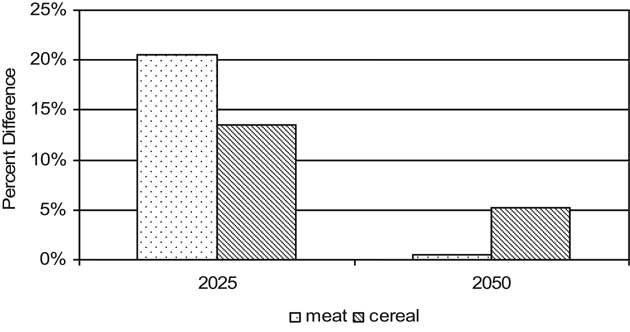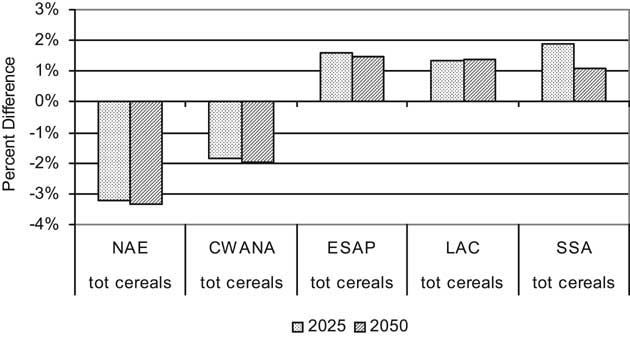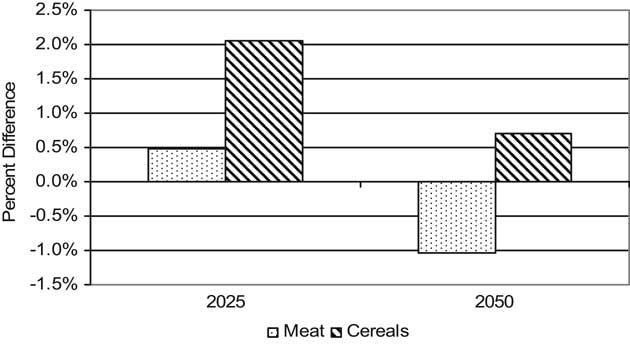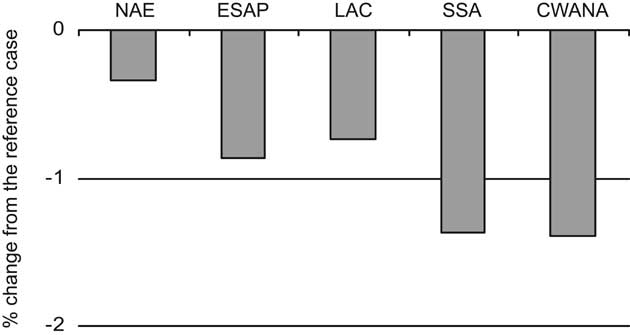
Figure 5-27. Projected impacts on global traded volumes of meats and cereals of decreased trade protection at 2025 and 2050. Source: IFPRI IMPACT model simulations.

Figure 5-28. Projected impacts on regional cereals production of decreased trade protection at 2025 and 2050. Source: IFPRI IMPACT model simulations.

Figure 5-29. Projected impacts on world meat and cereal prices of decreased trade protection at 2025 and 2050. Source: IFPRI IMPACT model simulations.

Figure 5-30. Projected impacts on gross regional product of increased trade protection under variant 2 at 2025. Source: GTEM.
5.4.3 Investment in AKST
As has been described above, the reference run describes slowly declining rates of growth in agricultural research (and extension). In the following, two alternative variations are analyzed using two sets of changing parameters. The first set of variations looks at different levels of investments in agriculture during 2005-2050. Different levels of investments can result in either higher (AKST_high) or lower crop yield and livestock numbers growth (AKST_low). The second set of variations analyzes the implications of even more aggressive or reduced growth in agricultural R&D together with advances in other, complementary sectors (AKST_high_pos and AKST_low_neg with "pos" for higher investments in complementary infrastructure and social services and "neg" for decelerating growth in these services). Such other sectors include investments in irrigation infrastructure (represented by accelerated or slowing growth in irrigated area and efficiency of irrigation water use and by accelerated or reduced growth in access to drinking water, and changes in investments of secondary education for females, an important indicator for human well-being (Tables 5-16 and 5-17).
Results of the four alternative variations are presented in Figures 5-37 to 5-45 and Table 5-18 and 5-19. The AKST high variant, which presumes increased investment in AKST, results in higher food production growth and reduced food prices and makes food more affordable for the poor when compared to the reference world. As a result, demand for cereals is projected to increase both as food and as feed, by 339 million tonnes or 13% (Figure 5-31 and Table 5-17). The combination of even more aggressive investment in AKST with sharp increases in expenditures for supporting social services results in even higher demand for cereals as both food and feed, 633 million tonnes or 24%. On the other hand, if levels of investment in AKST drop somewhat faster than in recent decades and if investments in key supporting services are not strengthened, food prices would rise, and demand would be depressed.
Despite these strong changes in AKST behavior, yield growth will continue to contribute most to future cereal production growth under both the AKST_low and AKST_high variants (Figures 5-38 and 5-39). However, under AKST_ low, area expansion would contribute 38% to production